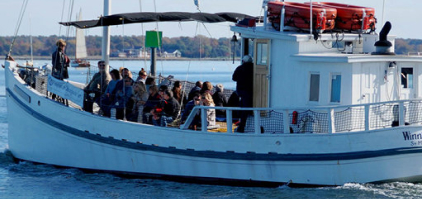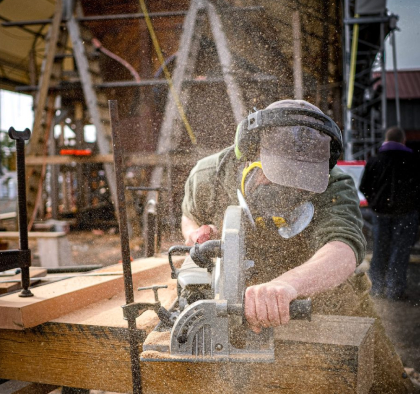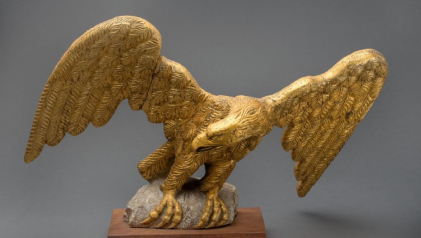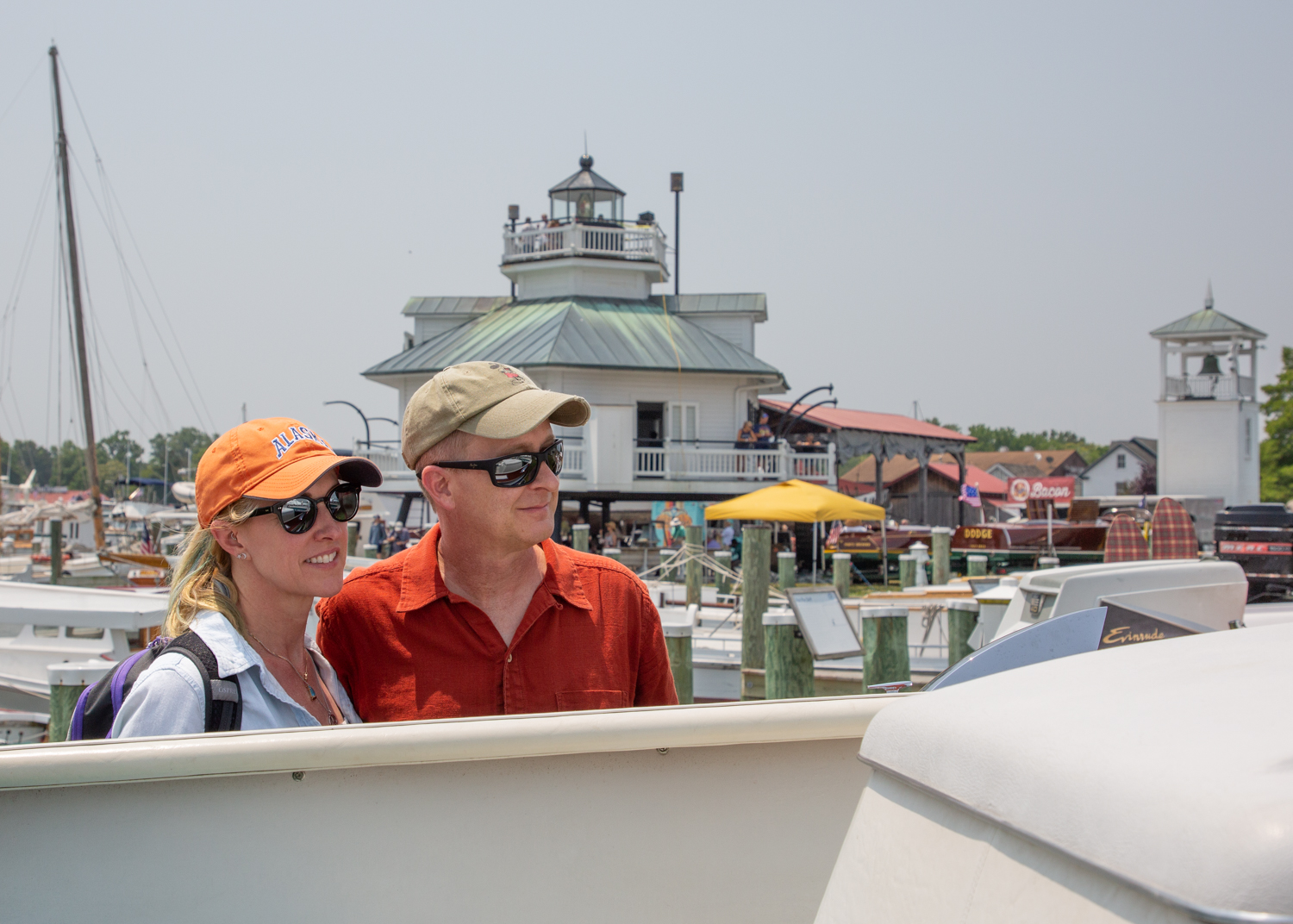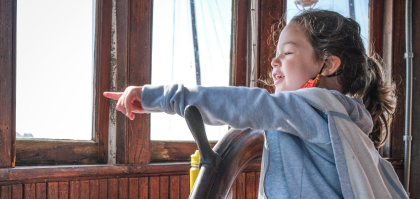CBMM debuts Museum Masters summer camp

CBMM’s Exhibition Designer & Projects Manager Jim Koerner leads students in the Museum Masters summer camp on a tour of the new Welcome Center. (Photo by Sharon Thorpe)
By Eric Detweiler, Communications Specialist
ST. MICHAELS, Md., July 26, 2023 – Caiden Sackett carefully stuck a long drawer back into a library card catalog cabinet and turned attention toward a thick blue book filled with hundreds of pages of journal entries from a 19th-century schooner captain.
“I feel like I’m on a scavenger hunt,” the 12-year-old from Easton said to his buddy Kenton Baynard.
The middle-school research partners were trying to learn all they could about a brass inkwell shaped like an alligator as part of Museum Masters summer camp at the Chesapeake Bay Maritime Museum.
Over the past two weeks, the newest offering in CBMM’s Summer Camp lineup gave children a unique look at CBMM’s extensive collection and a crash course on the responsibilities of a museum curator from artifact care to exhibition design.
Utilizing the newly renovated Norman & Ellen Plummer Center for Museum Collections, the Museum Masters campers used library materials and electronic resources to research real collection objects. They applied what they learned to create informational labels for the artifacts and combined their work to create an exhibition to share with their families and friends at an open house to close the week.
“I didn’t really know what to expect, but it’s so much fun,” said 12-year-old Ella Eckholm of Easton. “I thought it was just going to be going behind the scenes of the museum, but it’s way more than that. I love it.”
For CBMM, it was an opportunity to reach a different audience with its summer programming by creating a camp that showcased its enhanced collections and research space and shared the expertise of its curatorial staff with the next generation.
“I’m really proud of the impact that Museum Masters has had on the campers who participated,” CBMM Vice President of Education & Interpretation Jill Ferris said. “It’s very common for a museum to be a space where kids and families can come and have an enjoyable time, but what’s pretty unique about this is that the campers are able to delve into our collections and conduct real research to investigate what is interesting to them.”

CBMM debuted its Museum Masters summer camp this month, providing campers a unique look at its extensive collection and a crash-course on the responsibilities of a museum curator from artifact care to exhibition design.
The new camp – with one week geared toward grades 4-6 and the other grades 6-9 – was a collaboration between CBMM’s education and curatorial teams.
Museum Educator Alyssa Zajan leaned on a master’s degree in Museum Studies and assistance from Director of Curatorial Affairs & Exhibitions Jen Dolde, Museum Collections Specialist Gabriella Cantelmo, and Registrar Amanda Wachowiak to create age-appropriate lesson plans. Together, the team combed through CBMM’s collection of more than 80,000 artifacts to identify research options that would both interest and engage the campers.
Beyond the exhibition creation project, the highlights included a field trip day (one group went to Easton’s Academy Art Museum and the other to the Harriet Tubman Underground Railroad Visitor Center in Dorchester County), an afternoon of kayaking, a tour of CBMM’s under-construction Welcome Center led by Exhibition Designer & Projects Manager Jim Koerner, and time for the sort of fun and games that are a hallmark of summer camps everywhere.
“We’ve all talked about how this is the camp we would’ve wanted to go to as children,” Zajan said. “Creating it, we were guided by, ‘What would we have wanted to do when we were that age?’”
Dolde was eager to share all the ways that the Plummer Center can be used for historical research to tell stories about the history and culture of the Chesapeake Bay region.
In one particularly enlightening lesson, Dolde showed the children how to use a card catalog and then find their selections within the rows of books in the Howard I. Chapelle Library. When she asked the middle school group if anyone had ever seen a card catalog, one girl spoke up and said she remembered seeing one in the 1985 classic movie “The Breakfast Club.”
In today’s world, digital research is, of course, just as important, and Dolde also explained how to navigate CBMM’s online collections portal and take nuggets gleaned there into searching the wider web for reliable sources.
“We’re sharing a whole wider world of how to investigate history,” Dolde said. “It’s very different than just writing a paper.”
The result was fresh research into the chosen artifacts, many of which have been part of the collection for decades, and a chance to improve the information within their digital record.
In one case during the opening week, 10-year-old Carter Woody picked a purse, crab picking tools, and a glove that were originally catalogued without much additional information. Thanks to the camper’s research, the digital file now includes a photo of crab picker Fannie McCain Brooks and new details about her 35 years working in the industry in Hampton, Va.
“That is what this camp is all about,” Ferris said. “They are doing real research with real objects in our real collection, and it’s had a real impact on our understanding of life in the Chesapeake.”

CBMM’s Director of Curatorial Affairs & Exhibitions Jen Dolde shows students in the Museum Masters summer camp a painting of the schooner City of Baltimore in storage within the Norman & Ellen Plummer Center for Museum Collection
The artifacts the children picked spanned a wide spectrum of topics, locations, and eras of Chesapeake history, from a hand drill used for boat building, to a small decorative decoy, to a fishing trophy, to a Bay-themed license plate.
A member of CBMM’s Rising Tide after-school program, Eckholm picked a 1930s oyster shucking knife that was believed to be used by inspectors in Maryland’s Fishery Force, sparking a weeklong journey into the world of oystering.
Hudson Loveday was intrigued by a small lantern. The 13-year-old from Bethesda, Md., came to learn that it was a running light off a World War I power boat with a file that included a scan of a hand-written note from the donor Herman A. Hobelmann asking CBMM to accept it into its collection in 1975.
“I wanted to come because it sounded like fun,” Loveday said. “Definitely different than a chess or sports camp. Not a lot of places would offer something like this.”
For the 19 students who participated across the two weeks, it was an opportunity to start building research skills that will be useful in class projects going forward and perhaps one day even a career.
Caiden Sackett and Kenton Baynard were up for the challenge, diving in to learn more about their brass alligator’s owner Capt. Leonard Tawes and his schooner City of Baltimore.
After leafing through the collection of Tawes’ journal entries, “Coasting Captain,” published in 1967, they headed off to collections storage with Dolde and Zajan to have a look at a painting of City of Baltimore that they thought might yield more clues.
“It’s about putting the dots together,” Sackett said. “You learn one thing and then there’s another thing that goes off of that and you keep going until you find the end piece.”
